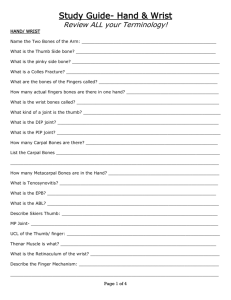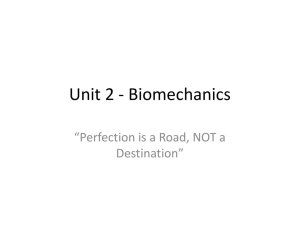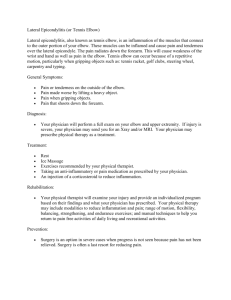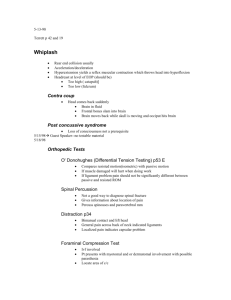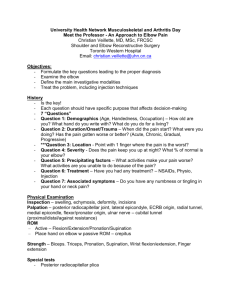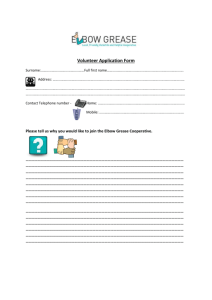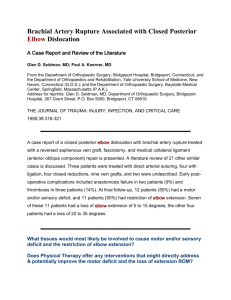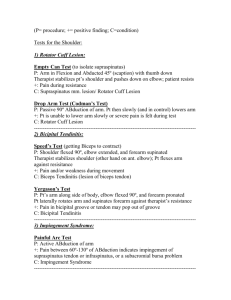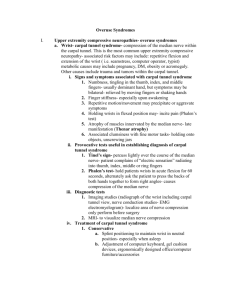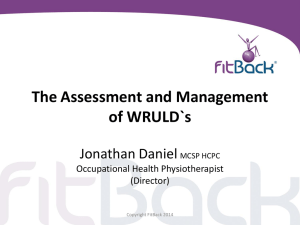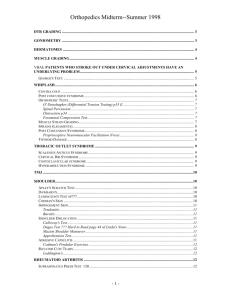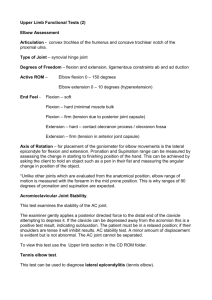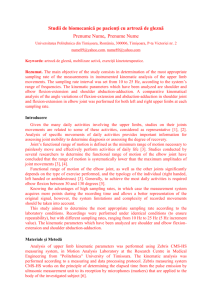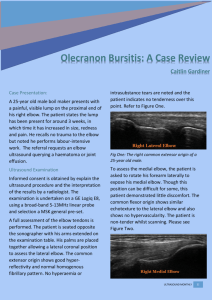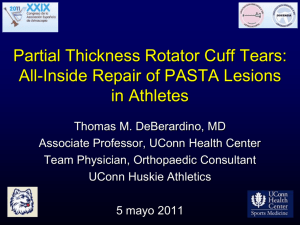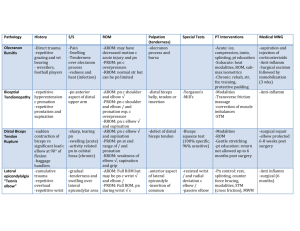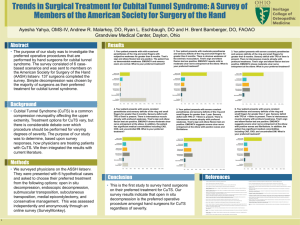backpain elbow shoulder lecture notes
advertisement
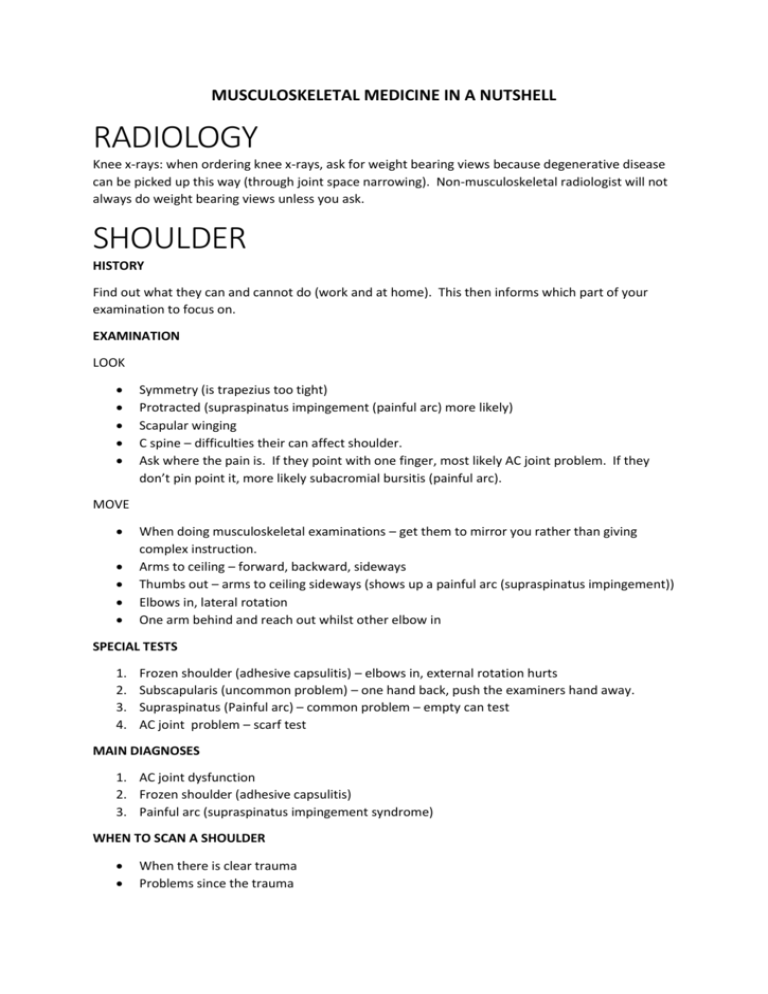
MUSCULOSKELETAL MEDICINE IN A NUTSHELL RADIOLOGY Knee x-rays: when ordering knee x-rays, ask for weight bearing views because degenerative disease can be picked up this way (through joint space narrowing). Non-musculoskeletal radiologist will not always do weight bearing views unless you ask. SHOULDER HISTORY Find out what they can and cannot do (work and at home). This then informs which part of your examination to focus on. EXAMINATION LOOK Symmetry (is trapezius too tight) Protracted (supraspinatus impingement (painful arc) more likely) Scapular winging C spine – difficulties their can affect shoulder. Ask where the pain is. If they point with one finger, most likely AC joint problem. If they don’t pin point it, more likely subacromial bursitis (painful arc). MOVE When doing musculoskeletal examinations – get them to mirror you rather than giving complex instruction. Arms to ceiling – forward, backward, sideways Thumbs out – arms to ceiling sideways (shows up a painful arc (supraspinatus impingement)) Elbows in, lateral rotation One arm behind and reach out whilst other elbow in SPECIAL TESTS 1. 2. 3. 4. Frozen shoulder (adhesive capsulitis) – elbows in, external rotation hurts Subscapularis (uncommon problem) – one hand back, push the examiners hand away. Supraspinatus (Painful arc) – common problem – empty can test AC joint problem – scarf test MAIN DIAGNOSES 1. AC joint dysfunction 2. Frozen shoulder (adhesive capsulitis) 3. Painful arc (supraspinatus impingement syndrome) WHEN TO SCAN A SHOULDER When there is clear trauma Problems since the trauma More in old than young (because older have degenerative tendons). If problem is of gradual onset – don’t scan. Tears are acute and present more suddenly. Younger people get tendinopathy with SA bursitis. ELBOW Things to know about the elbow: Elbow is linked to wrist and shoulder. Therefore those two areas can cause problems in the elbow. Carpal tunnel is common. But so is cubital tunnel syndrome – the cubital tunnel is in the elbow. Muscles attach to the elbow (from the shoulder) and originate from the elbow (to go the wrist). The flexors attach medially (remember FM as in FM radio). The extensors attach laterally. LOOK Swelling – nodules, effusion, bursitis Bruises Muscle wasting Erythema Scars Skin changes (psoriasis) Varus/valgus deformities MOVE Flexion, extension Supination, pronation Wrist flexion, extension (with forearm pronated) – against resistance, wrist extension should cause lateral elbow pain (extensors attach laterally), wrist flexion should cause medial elbow pain (remember FM). When doing resistance examination say ‘don’t let me move you’ rather than ‘don’t let me pull’ etc. FEEL Lateral and medial epicondyles. NEURAL TENSION TESTS – on the elbow MEDIAN NERVE Cock hand up, then abduction – for more stress, laterally flex neck away from side being tested. RADIAL NERVE Waiters tip, extension ULNAR NERVE Owls eye with fingers KEEP SHOULDERS DOWN – don’t let them pull them up. A positive test is if their symptoms are reproduced OR a difference between sides noted. CUBITAL TUNNEL SYNDROME Ulnar nerve is affected here. Tap just below medial epicondyle (where cubital tunnel is). Tapping causes ulnar tingling. BACK PAIN A full time GP sees 250 back pains per year. Do not medicalise back pain. Most back pain should be self-management. Humans were designed to live to around 50 years. Degenerative change is NORMAL with age and does not necessarily cause symptoms (eg elderly person can have osteopenia with degenerative back disease with no back trouble at all). Therefore normalise, not medicalise. We get grey hair and wrinkles as we age – that is another example of degeneration which doesn’t cause problems. Don’t image. 20-30% of images disclose ASYMPTOMATIC disc herniation. Only image if red flags – in other words for the exclusion of serous disease NOT diagnosis. (eg 18y old with thoracic back pain after an injury). Imaging is not useful for LBP, neck or knee. Only do hip knee x-ray when you plan to replace them with artificial joints. Radiologist will often write ‘degenerative disc disease’. But this is not a disease. It is merely ageing. And it isn’t always linked with pain or problems. SO…. With back pain sufferers Take a history (identify their health beliefs around the back pain, aswell as nature of the problem). Examination – although examination doesn’t give that great information about back pain diagnosis (85% of back pain cannot be given a definitive diagnosis even with imaging), patients expect it. If you don’t do it, they lose faith in you. Besides it is an opportunity to give feedback : ‘Oh dear, your core back muscles are really tense, you need to work on those. Work on abnormal beliefs and delete/edit them. Abnormal beliefs are responsible for recurrent presentations and demanding requests. Also work on catastrophic thinking (am I going to get arthritis, be wheel chair bound) Explain why an xray is not needed (something patients expect) Explain why a specialist referral is not necessary (something patients usually expect). Ask if they want medication rather than assuming they do. Many don’t! Work on self management. In acute back pain Simple analgesia Rest for no more than 1-3 days Excercises Book: the back pain revolution

